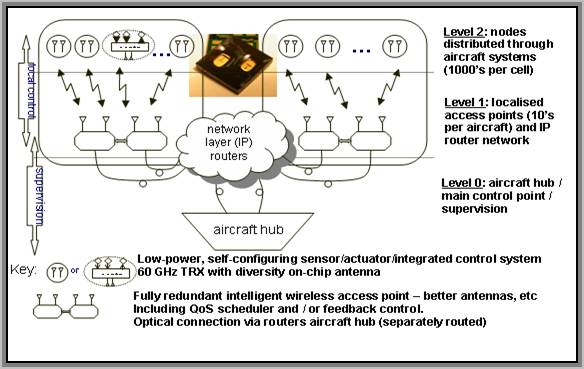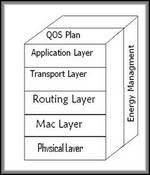Wireless Interconnectivity and Control of Active Systems (WICAS) Active Aircraft
| Researchers: Dr William Scanlon and Nauman Israr (ECIT), Prof. GW Irwin (ISAC), Prof. Haydn Thompson (RR UTC), Max Ong (Sheffield) |  |
| WICAS at The University of Shefield |
Introduction
The Active Aircraft project aim at providing an intrinsically robust and certifiable wireless networking capability to create an advanced nervous system for future aircraft. The wireless nervous system will support a large number of sensors and actuators for active flow control and also exploit the wireless network to support a variety of other aircraft subsystems reducing wiring weight and complexity which will enable airbus ACARE VISION2020 targets, allowing sustained air travel growth whilst having zero additional environmental impact.
Architecture
The proposed WICAS architecture at level 2 comprise of large number of system devices (nodes) such as sensors, actuators, controllers are distributed throughout the aircraft and, without particular regard to function, are grouped into localised cells, each with their own Level 1 wireless access point. Using microwave or millimetre-wave transceivers, the extent of each cell is not expected to exceed a few metres but, in any case, would be subject to operating frequency, throughput, propagation and cost constraints. The cells would each operate on non-overlapping frequency channels in the same manner as a cellular or WLAN network.
 Fig 1. General Architecture of the WICAS
Fig 1. General Architecture of the WICAS

Communication Framework for WINCS
The protocol stack for Wireless Nervous System communication comprises of the following layers
- Application layer
- Transport Layer
- Network Layer(Routing Layer)
- Data Link Layer(Medium Access Layer)
- Physical Layer
The Application layer is responsible for topology management of the network by employing clustering strategies for localising changes in the network and sleep/wakeup scheduling for reliability and energy efficiency. The transport layer helps to maintain the flow of the data. The routing layer is responsible for routing data to the destination via the optimal energy efficient route using single hop or multi hop. Since wireless mediums are traditionally noisy, the data link layer or the MAC layer should be able to reduce collisions to increase the lifetime of the network. For continuous data traffic a Time Division Multiplex Access (TDMA) scheme for the Medium Access Control (MAC) layer is efficient in terms of energy and bandwidth. For event driven traffic the Carrier Sense Multiple Access with Collision Avoidance (CSMA/CA) is efficient in terms of bandwidth utilisation. The physical layer is responsible for the transmission of data using a specific carrier frequency, using robust modulation and demodulation technique. In general, to transmit a signal over a distance d is proportional to d^n where 2<=n<4. The QOS and the energy management plan runs across all the layers. Since we aim to design the protocol as cross layer solution in which every layer tries to achieve the desired QOS at the same time achieving energy efficiency.
QUB SimulNet 802.11 (Matlab / Simulink)
An open simulation environment will be developed in Matlab / Simulink based on QUB’s SimulNet IEEE 802.11-based co-simulator to incorporate priorities and support for cross layer network protocols. The new simulator will support the investigation and rapid prototyping of wireless systems for the specific needs of the active aircraft. This will allow assessment of different architecture options and communication protocols and analysis of sub-system performance and other issues such as scalability and redundancy.
60GH Technology
Very high data-rate wireless communications is becoming a reality with the opening of the 60GHz band, and the increasing speed and integration of analog circuitry in CMOS. The 60GHz is now available worldwide for unlicensed commercial use. The attraction of this band is its large bandwidth of 7GHz and the lack of restrictions. There is only a maximum power restriction, on the order of +40dBm. 60 GHz benefits from O2 absorption effects (12 dB/km) and high losses through most materials, including composites, inherently protecting aircraft from malicious attacks whether inside or outside the aircraft.
References
- G.A. Safdar & W.G. Scanlon, “Improved power-saving medium access protocol for IEEE 802.11e QoS-enabled wireless networks,” IET Communications.
- J. Colandairaj, G.W. Irwin & W.G. Scanlon, “Wireless networked control systems with QoS-based sampling,” IET Control Theory & Applications, Vol. 1, 1, pp. 430–438, Jan. 2007.
